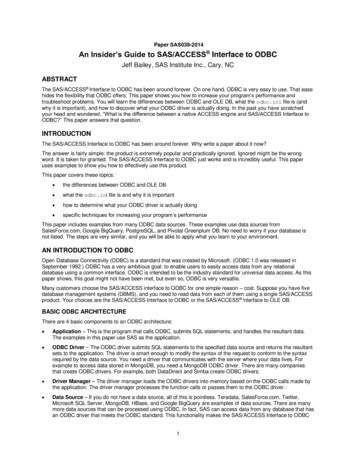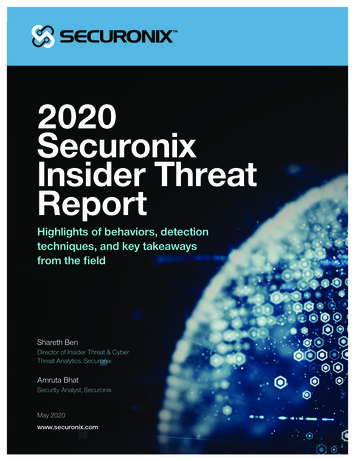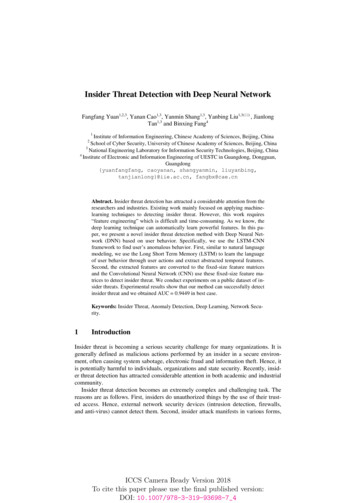
Transcription
Paper SAS039-2014An Insider’s Guide to SAS/ACCESS Interface to ODBCJeff Bailey, SAS Institute Inc., Cary, NCABSTRACTThe SAS/ACCESS Interface to ODBC has been around forever. On one hand, ODBC is very easy to use. That easehides the flexibility that ODBC offers. This paper shows you how to increase your program’s performance andtroubleshoot problems. You will learn the differences between ODBC and OLE DB, what the odbc.ini file is (andwhy it is important), and how to discover what your ODBC driver is actually doing. In the past you have scratchedyour head and wondered, “What is the difference between a native ACCESS engine and SAS/ACCESS Interface toODBC?” This paper answers that question.INTRODUCTIONThe SAS/ACCESS Interface to ODBC has been around forever. Why write a paper about it now?The answer is fairly simple: the product is extremely popular and practically ignored. Ignored might be the wrongword. It is taken for granted. The SAS/ACCESS Interface to ODBC just works and is incredibly useful. This paperuses examples to show you how to effectively use this product.This paper covers these topics: the differences between ODBC and OLE DB what the odbc.ini file is and why it is important how to determine what your ODBC driver is actually doing specific techniques for increasing your program’s performanceThis paper includes examples from many ODBC data sources. These examples use data sources fromSalesForce.com, Google BigQuery, PostgreSQL, and Pivotal Greenplum DB. No need to worry if your database isnot listed. The steps are very similar, and you will be able to apply what you learn to your environment.AN INTRODUCTION TO ODBCOpen Database Connectivity (ODBC) is a standard that was created by Microsoft. (ODBC 1.0 was released inSeptember 1992.) ODBC has a very ambitious goal: to enable users to easily access data from any relationaldatabase using a common interface. ODBC is intended to be the industry standard for universal data access. As thispaper shows, this goal might not have been met, but even so, ODBC is very versatile.Many customers choose the SAS/ACCESS interface to ODBC for one simple reason – cost. Suppose you have fivedatabase management systems (DBMS), and you need to read data from each of them using a single SAS/ACCESSproduct. Your choices are the SAS/ACCESS Interface to ODBC or the SAS/ACCESS Interface to OLE DB.BASIC ODBC ARCHITECTUREThere are 4 basic components to an ODBC architecture: Application – This is the program that calls ODBC, submits SQL statements, and handles the resultant data.The examples in this paper use SAS as the application. ODBC Driver – The ODBC driver submits SQL statements to the specified data source and returns the resultantsets to the application. The driver is smart enough to modify the syntax of the request to conform to the syntaxrequired by the data source. You need a driver that communicates with the server where your data lives. Forexample to access data stored in MongoDB, you need a MongoDB ODBC driver. There are many companiesthat create ODBC drivers. For example, both DataDirect and Simba create ODBC drivers. Driver Manager – The driver manager loads the ODBC drivers into memory based on the ODBC calls made bythe application. The driver manager processes the function calls or passes them to the ODBC driver. Data Source – If you do not have a data source, all of this is pointless. Teradata, SalesForce.com, Twitter,Microsoft SQL Server, MongoDB, HBase, and Google BigQuery are examples of data sources. There are manymore data sources that can be processed using ODBC. In fact, SAS can access data from any database that hasan ODBC driver that meets the ODBC standard. This functionality makes the SAS/ACCESS Interface to ODBC1
very popular with SAS users. (Note: The terms “data source” and “data source name” are often usedinterchangeably.)WHAT IS THE DIFFERENCE BETWEEN ODBC AND OLE DB?ODBC was designed to handle the data needs of SQL-based data sources. These data sources are typicallyrelational databases. ODBC has been expanded to include non-relational databases that have their data stored incolumns and rows.Also developed by Microsoft, OLE DB is an open standard and was developed to handle data of any format. OLE DBis not SQL based. Here are some examples of non-relational data that OLE DB can handle: hierarchical databases,e-mail, file system stores, text, custom business objects, geographical data, and more.ODBC is procedural based. OLE DB is component based.ODBC does not support locking while OLE DB supports several locking models.OLE DB has slightly better performance characteristics. Note this improved performance might not be true across theboard. Be sure to test the specific ODBC drivers and OLE DB providers to determine the performance for yourenvironment.OLE DB was intended to replace ODBC but that has not happened. ODBC has very mature drivers that work reliablyin the field. OLE DB is less mature and does not have the reassuring reputation that ODBC enjoys.CONNECTING TO ODBC DATA SOURCESAn ODBC Data Source stores information that enables a client (such as SAS) to connect to a server. Each datasource is given a name. A data source name (DSN) is the name assigned to a set of connection information. Youdetermine the DSN for your connection. The name should be descriptive, easy to remember, and (if it will be used byothers) easy to understand. Poorly chosen names can cause confusion.This connection information can include: Data Source Name (DSN), which is chosen by the user ODBC driver – the software that allows us to interact with external data server name port number user ID passwordHere is an example. Assume that you need to connect to Google’s BigQuery using SAS. To do this, you need anODBC driver (such as BigQuery ODBC Driver from Simba), a Google account (which consists of a user ID andpassword), and a security token (that you get from Google). Add this connection information to an ODBC datasource, and you have a valid ODBC data source. Now, you can access BigQuery data from your SAS programs. InFigure 1, the items in the Systems Data Sources box are circled. The first item in the list is Google BigQuery, whichis the data source name.2
Figure 1. Systems Data Sources Box Shows the Google BigQuery Data Source NameCREATING AN ODBC DATA SOURCE IN WINDOWS ENVIRONMENTSConfiguring ODBC data sources in Windows environments is fairly easy. Use the ODBC Data Source Administratorto create these data sources. This process is documented in many places, so there is no need to do that here. Thispaper discusses the portions of the utility that are important (or often overlooked). Figure 2 shows the System DSNtab in the ODBC Data Source Administrator.Figure 2. The Systems DSN Tab in the ODBC Data Source AdministratorUse the User DSN tab to create data sources that will only be visible to you. This tab is not used very often. Typically,your software creates the default data sources that are listed in this tab. For example when you install ODBC drivers,the drivers create the sample data sources that are listed in this tab.Use the System DSN tab to create data sources that will be visible to all users on the machine. In this case usersincludes Windows NT services, which could be running on the machine. For an example of the System DSN tab, seeFigure 2.Use the File DSN tab to create data sources that are stored as files. You can share these data sources with otherusers who have the specified driver installed. Some organizations use this type of data source to distribute3
connection information to their users (typically in support of production applications). Figure 3 shows the File DSNtab. In this example, a Teradata file data source is defined.Figure 3. A File Data Source on the File DSN TabThe Drivers tab is one of the most useful tabs in the ODBC Data Source Administrator. Use this tab to determine theversion number of a specific ODBC driver. For example, suppose you need to know which version of the TeradataODBC driver is installed on a machine. Figure 4 shows the Teradata driver, and the version of the driver is14.10.00.00.Figure 4. Determining the Version Number of a Driver on the Drivers TabFigure 5 shows the Tracing tab. This tab shows the ODBC API commands and SQL code generated by the ODBCdriver. Use the options in this tab to specify where to write the output log and click Start Tracing Now. That is allthere is to it. Remember to turn tracing off when you are finished. After tracing starts, the Start Tracing Now buttonchanges to the Stop Tracing Now button.4
Figure 5. How to Start and Stop ODBC Tracing Using the ODBC Data Source AdministratorCREATING AN ODBC DATA SOURCE NAME ON UNIXUnlike Windows environments, UNIX environments do not provide GUI tools to help you configure your ODBCconnections. It is just you and the vi editor. Actually, your systems administrator will probably do this configurationfor you. This paper assumes that you have your ODBC drivers installed, your environment variables set properly, anda valid odbc.ini file.Before you start, ask your system administrator for the specifics for your environment. You probably can use anexisting configuration file, but for this to work, you must have the environment variables set properly. Setting theseenvironment variables is beyond the scope of this paper, but it is useful to know that you can use the environmentvariables to find the odbc.ini file on your system. The env command lists the environment variables for youraccount. The ODBCINI environment variable shows you the path for the odbc.ini file.Here are the ODBC-related environment variables from one of the UNIX systems at SAS:LD LIBRARY PATH /apps/odbc/dd7.10/lib: LD LIBRARY PATHODBCHOME /apps/odbc/dd7.10ODBCINI ./odbc.iniThe odbc.ini file is very important because it defines the DSNs and any customizable parameters for your ODBCenvironment. In UNIX environments, the odbc.ini file is a text file. In Windows enviroments, odbc.ini is an entryin the registry. The odbc.ini file contains information vital to the smooth running of your ODBC connections. Eachdriver is different, so the information required is also different. Figure 5 shows the Tracing tab of the ODBCAdministrator in Windows environments. To enable tracing on UNIX, you need to add entries to the odbc.ini file.The odbc.ini file is divided into stanzas. A stanza is the section that follows the bracketed text. Each DSN has itsown stanza. The opening stanza is [ODBC Data Sources]. Tracing is configured, and started, in the [ODBC]stanza.In this odbc.ini file, the [SalesForce] stanza contains all the information needed to connect to SalesForce.com.[ODBC Data Sources]Salesforce DataDirect 7.1 Salesforce[ODBC]IANAAppCodePage 4InstallDir /dbi/odbc/dd7.10Trace 0TraceFile odbctrace.out#TraceDll /dbi/odbc/dd7.10/lib/odbctrac.soTraceDll /dbi/odbc/dd7.10/lib/ddtrc26.so[Salesforce]Driver /dbi/odbc/dd7.10/lib/ddsfrc26.soDescription DataDirect 7.1 SalesforceApplicationUsingThreads 15
BulkLoadAsync 0BulkLoadBatchSize 1024BulkLoadConcurrencyMode 1BulkLoadFieldDelimiter BulkLoadPollInterval 10BulkLoadProtocol 0BulkLoadRecordDelimiter BulkLoadThreshold 4000BulkLoadTimeout 0ConnectionReset 0ConfigOptions CreateDB 2EnableBulkLoad FalseDatabase Extended Options FetchSize 100HostName InitializationString IANAAppCodePage JVMArgs -Xmx256mJVMClasspath LoadBalanceTimeout 0LogConfigFile LogonDomain LoginTimeout 15LogonID MaxPoolSize 100MinPoolSize 0Password Pooling 0ProxyHost ProxyPassword ProxyPort ProxyUser QueryTimeout 0ReportCodepageConversionErrors 0ReadOnly 0RefreshDirtyCache 1SecurityToken StmtCallLimit 20StmtCallLimitBehavior 2TransactionMode 0WSFetchSize 0WSRetryCount 0WSTimeout 120From this example, you can see that this code is more complicated than the code for Windows environments.Fortunately, you do not have to set all the parameters in this example. If you are ever in a situation where you need toconfigure an ODBC Data Source Name in Linux or UNIX environments, the best idea is to find a working exampleand copy it.It is very important to test your ODBC connections. The remainder of this paper is full of examples that show how toconnect to DBMSs using ODBC. Select your favorite example and use it for testing. An easy way of testing a DSN isto issue a LIBNAME statement using SAS. If you do not have SAS installed, you can use Microsoft Excel or anotherODBC enabled application for testing.CONNECTING TO AN ODBC DATA SOURCE USING SAS CODEThere are many ways to connect using SAS code, and this paper shows examples of all these connectiontechniques.6
CONNECTING USING PROMPTINGPrompts are helpful when you are using SAS Display Manager and cannot remember the syntax for the ODBCLIBNAME statement. Prompts are also useful when you need to create a DSN. Prompts work in Windowsenvironments and might work for some ODBC driver managers in Linux and UNIX environments.To connect to a Windows ODBC DSN using prompting:1.In the SAS Display Manager, enter and submit this LIBNAME statement:.LIBNAME myodbc ODBC PROMPT;The Select Data Source dialog box appears.2.In the Select Data Source dialog box, select the Machine Data Source tab. Now, select an existing DSN foryour connection, or click New to create a DSN.3.Complete the dialog boxes for your ODBC driver. Be sure to save your DSN. When you are finished, youcan connect to the data source, and your SAS library is assigned.USING A DSN CONNECTIONA DSN connection requires that you have an ODBC DSN defined by the ODBC Manager. You use this DSN in yourSAS code. This method of connecting to ODBC is very common.Here is an example of a DSN connection to a Microsoft SQL Server. Because the user ID and password are notstored in the DSN definition, they must be included in the LIBNAME statement.LIBNAME sqlodbc ODBC DSN ”MS SQL” User Jeff Password Jeff123;If the user ID and password are saved with the DSN (which is not recommended), the LIBNAME statement could bevery simple.LIBNAME sqlodbc ODBC DSN ”MS SQL”;Remember that you must have defined a DSN in order to use this technique. It is also worth mentioning that thevarious ODBC drivers differ greatly in complexity. So, your DSN connection might be more complicated than this one.USING A DSN-LESS CONNECTIONThere are three reasons why you might want to use a DSN-less connection. First, you can bypass the need to createa DSN using the ODBC Data Source Administrator. Second, because you are bypassing the administrationapplication, the connections do not take as long. Connecting takes time. If you find yourself reconnecting to the sameDSN, using the DSN-less technique might enable your jobs to run faster. Third, it is easy to include seldom-used orcustom connections. In other words, you can set connections parameters without having to create a DSN or edit the7
odbc.ini file.Creating the DSN-less connection is not difficult. You use the LIBNAME statement with the CONNECT option. Youmust look up name of the ODBC Driver to get this to work, but that is easy. You can find this name in the Drivers tabin the ODBC Data Source Administrator or in the odbc.ini file. Specific options for the driver can sometimes befound using the “trick” discussed in the “How Do I Find the Options Available for My ODBC Driver?” section of thispaper. Unfortunately, this “trick” does not work for SaleForce.com, but do not worry. It is relatively easy to find thisinformation using the Windows registry or an odbc.ini file on UNIX.Here is a LIBNAME statement that uses a DSN-less connection to SalesForce.com.LIBNAME mySF ODBC COMPLETE DRIVER {DataDirect 7.1SalesForce};Database SFORCE;HostName login.sas.com;UID myuser@myemail.com;PWD MACE TUNINGUnfortunately, there is no one-size-fits-all guide to performance tuning. However, here are some principles that canhelp you improve performance: The ODBC drivers have options that can be useful for performance tuning. You can make your programs run faster by making your SQL run faster.HOW DO I FIND THE OPTIONS AVAILABLE FOR MY ODBC DRIVER?There are times that you need to know the specific options that can be used with your ODBC driver. Looking up thisinformation can be painful. Fortunately, you can sometimes use SAS to display these options. It might not work all thetime, but it does work most of the time. This example uses prompting to display these options.To display the options for an ODBC driver:1.In the SAS Display Manager (or SAS Enterprise Guide), enter and submit the following LIBNAME statement. Youdo not have to use the PROMPT keyword. You can submit a LIBNAME statement and all the connection options.LIBNAME myodbc ODBC PROMPT;2.In Select Data Source dialog box, select the DSN to use for the connection. You must have the specificconnection information (which includes the server name, user ID, and password) required by the database.3.Enter the following SAS macro code into SAS Display Manager (or SAS Enterprise Guide) and submit it.%PUT %SUPERQ(sysdbmsg);Error! Reference source not found. shows the output in the SAS log after connecting to Aster Data.1libname adata odbc prompt;NOTE: Libref ADATA was successfully assigned as follows:Engine:ODBCPhysical Name: nCluster2%put %superq(sysdbmsg);ODBC:DSN nCluster;DATABASE indb;SERVER asterdata.somename.com;PORT 2406;UID user;PWD userpw1;SSLmode disable;ReadOnly 0;Protocol 7.4;FakeOidIndex 0;ShowOidColumn 0;RowVersioning 0;ShowSystemTables 0;ConnSettings ;Fetch 100;Socket 4096;UnknownSizes 0;MaxVarcharSize 8000;MaxLongVarcharSize 8190;Debug 0;CommLog 0;Optimizer 1;Ksqo 1;UseDeclareFetch 0;TextAsLongVarchar 1;UnknownsAsLongVarchar 0;BoolsAsChar 1;Parse 0;CancelAsFreeStmt 0;ExtraSysTablePrefixes dd ;;LFConversion 1;UpdatableCursors 1;DisallowPremature 0;TrueIsMinus1 0;BI 0;ByteaAsLongVarBinary 0;UseServerSidePrepare 0;LowerCaseIdentifier 0;Output 1. Log Output from the %PUT MacroThe output shows that there are a lot of parameters available for the Aster Data ODBC driver. Fortunately, you arenot required to set them all. Any parameters that you do not specifically set use a default value.8
If this trick does not work for your ODBC driver, do not worry because there are still ways to find this information. InWindows environments, look at odbc.ini entry in the registry. The registry key is Computer\HKEY . In Linux andUNIX environments, look in the odbc.ini file. Figure 6 shows the ODBC information for the DataDirectSalesForce.com driver.Figure 6. ODBC Driver Options in the Windows RegistryAs previously discussed, performance tuning is not a one-size-fits-all situation. Each driver has options that canimprove performance. When you have performance issues with SAS/ACCESS to ODBC, the first thing to do is findthe list of options for your ODBC driver. Research any option that determines buffersizes or number of rows for aninsert or read. Output 1 shows that the Aster Data ODBC driver has a Fetch 100 option. Experiment with this optionby increasing its value and running tests. Ideally, the performance improves. Make sure that you read theSAS/ACCESS Interface to ODBC chapter in the SAS/ACCESS 9.4 for Relational Databases: Reference. Pay closeattention to these SAS options.DBCOMMIT number-of-rowsThis option affects how UPDATE, DELETE, and INSERT statements are made permanent (committed) inthe DBMS. Setting DBCOMMIT 0 commits all changes after the procedure or DATA step completes. Zero isoften the best setting, but experiment with this value in order to choose a good one. Note that theDBCOMMIT and INSERTBUFF options interact. For more information, see the SAS/ACCESSdocumentation.Here are the default values for the DBCOMMIT option: 1000 when a table is created and rows are inserted in a single step. 0 when rows are inserted, updated, or deleted from an existing table.INSERTBUFF number-of-rowsThis option helps improve performance by increasing the number of rows in a single DBMS insert. Thedefault is one row per insert. You should increase this value. The maximum value is DBMS dependent andis seldom the best choice. What is the best choice? It depends on the amount of memory that is available.Finding an acceptable value requires experimentation. Remember that this option interacts with theDBCOMMIT option. For more information, see the SAS/ACCESS documentation.READBUFF number-of-rowsThis option helps improve performance by increasing the number of rows read during a fetch. The default isone row per fetch. You should increase this value. The maximum value is 32,767 rows per fetch, but thisvalue is seldom the best choice. What is the best choice? It depends on the amount of memory that isavailable. Finding an acceptable value requires experimentation.The UseServerSidePrepare PostgreSQL ODBC driver parameter is particularly interesting if you are accessingPostGreSQL. Setting this to 1 can greatly increase query performance. This option can also increase performance ofthe SAS/ACCESS Interface to PostgreSQL, which also uses ODBC.9
The bad news is that there is no magic bullet. Each data source requires different tuning. Fortunately, just seeing thelist of available options can help you with performance tuning. It is the helping hand to get you started. If your datasource is a database, there are also things you can do outside of ODBC.HOW DO I MAKE MY SQL QUERIES RUN FASTER?This paper does not cover query tuning. Other papers (see “The SQL Tuning Checklist: Making Slow Queries a Thingof the Past” in the References section) have been written about that topic. One of the first steps in tuning a query is torun an OPTIONS statement in order to understand what SAS is asking the database to do.OPTIONS SASTRACE ',,,d' SASTRACELOC saslog NOSTSUFFIX;Here is an example of an OPTIONS statement in your SAS code:LIBNAME tdodbc ODBC DSN "Teradata ODBC" schema eecdata;OPTIONS SASTRACE ',,,d' SASTRACELOC saslog NOSTSUFFIX;PROC SQL NOEXEC;SELECT a.store id, a.transaction id, b.date id, b.employee rkFROM tdodbc.order fact a, tdodbc.order fact bWHERE a.store id 1182041AND b.date id '31JAN2004'd;QUIT;Output 2 shows the results of running this code. The SQL that is being submitted to Teradata appears in bold. Afteryou have this SQL code, you can tune it. Remember that a lack of indexes and missing (or out-of-date) statisticscause a lot of SQL performance problems. (For more information, see “The SQL Tuning Checklist: Making SlowQueries a Thing of the Past” in the References section.)1LIBNAME tdodbc ODBC DSN "Teradata ODBC" schema eecdata;NOTE: Libref TDODBC was successfully assigned as follows:Engine:ODBCPhysical Name: Teradata ODBC23OPTIONS SASTRACE ',,,d' SASTRACELOC saslog NOSTSUFFIX;45PROC SQL NOEXEC;6SELECT a.store id, a.transaction id, b.date id, b.employee rk7FROM tdodbc.order fact a8, tdodbc.order fact b9WHERE a.store id 118204110AND b.date id '31JAN2004'd;ODBC: AUTOCOMMIT turned ON for connection id 0ODBC 1: Prepared: on connection 0SELECT * FROM eecdata.order factODBC 2: Prepared: on connection 0SELECT * FROM eecdata.order factODBC 3: Prepared: on connection 0select a."STORE ID", a."TRANSACTION ID", b."DATE ID", b."EMPLOYEE RK" fromeecdata.order facta, eecdata.order fact b where (a."STORE ID" 1182041)and (b."DATE ID" {d '2004-01-31' })NOTE: Statement not executed due to NOEXEC option.11QUIT;10
NOTE: PROCEDURE SQL used (Total process time):real time0.02 secondscpu time0.03 secondsOutput 2. Output from the SASTRACE and SASTRACELOC OptionsWHAT IS THE DIFFERENCE BETWEEN AN ODBC-BASED ACCESS ENGINE ANDSAS/ACCESS TO ODBC?The SAS/ACCESS Interface to ODBC is a general use SAS/ACCESS engine designed to work with the ODBCdrivers at your site. Here are some SAS/ACCESS engines for specific databases that use ODBC underneath thecovers: SAS/ACCESS Interface to Aster SAS/ACCESS Interface to Greenplum SAS/ACCESS Interface to Impala SAS/ACCESS Interface to Microsoft SQL Server SAS/ACCESS Interface to MySQL SAS/ACCESS Interface to PostgreSQL SAS/ACCESS Interface to SAP HANA SAS/ACCESS Interface to VerticaThese SAS/ACCESS engines differ from SAS/ACCESS to ODBC in many ways: They are shipped with a SAS branded ODBC driver. They provide support for bulk loading using a vendor supplied utility. They support SQL statements (for example, UPDATE and DELETE) that are not support by the standardSAS/ACCESS engine. They support internationalization (I18N). They are capable of pushing more functions to the database, which makes the SQL processing faster.CONCLUSIONThe SAS/ACCESS Interface to ODBC is a very versatile product that enables you to access data from many datasources. Using ODBC data sources with SAS is not difficult, but there are lots of things to remember. This paper hasshown many examples of how to connect to an ODBC data source using SAS LIBNAME statements and the SQLprocedure. This paper has also demonstrated the DSN and DSN-less connection techniques and techniques that youcan use to tune the performance of your SAS/ACCESS to ODBC programs. Your next step is to use these tricks andtechniques to explore the ODBC data sources that you use every day. Make sure you read the SAS/ACCESSdocumentation so that you can get the most from SAS/ACCESS to ODBC.REFERENCESBailey, Jeff. 2010. “Troubleshooting SAS and Teradata Query Performance Problems.” Cary, NC: SAS Institute, Inc.Available Accessed on February 19, 2014.Bailey, Jeff. Petrova, Tatyana. 2013. “The SQL Tuning Checklist: Making Slow Database Queries a Thing of thePast.” Proceedings of the SAS Global Forum 2013 Conference. Cary, NC: SAS Institute Inc. Available ings13/080-2013.pdf.ACKNOWLEDGMENTSThe author extends his heartfelt thanks and gratitude to the following individuals:11
David Baccanari Jr., Progress Software CorporationPat Buckley, SAS Institute Inc.Chris DeHart, SAS Institute Inc.Marie Dexter, SAS Institute Inc.Salman Maher, SAS Institute Inc.Tom Newton, Simba Technologies Inc.Tatyana Petrova, SAS Institute Inc.RECOMMENDED READINGSAS/ACCESS 9.4 for Relational Databases: Reference, Third Edition. Available ldb/66787/PDF/default/acreldb.pdfCONTACT INFORMATIONYour comments and questions are valued and encouraged. Contact the author:Jeff Bailey100 SAS Campus DriveCary, NC 27513SAS Institute Inc.Jeff.Bailey@sas.comhttp://www.sas.comSAS and all other SAS Institute Inc. product or service names are registered trademarks or trademarks of SASInstitute Inc. in the USA and other countries. indicates USA registration.Other brand and product names are trademarks of their respective companies.12
product. Your choices are the SAS/ACCESS Interface to ODBC or the SAS/ACCESS I. nterface to OLE DB. BASIC ODBC ARCHITECTURE . There are 4 basic components to an ODBC architecture: Application - This is the program that calls ODBC, submits SQL statements, and handles the resultant data. The examples in this paper use SAS as the application.










